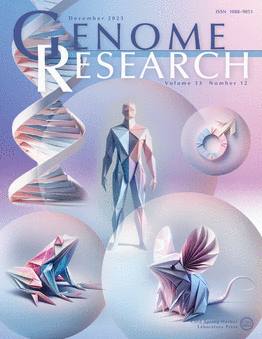The SeqSplice multiplexed minigene splicing assay for characterization and quantitation of variant-induced BRCA1 and BRCA2 splice isoforms
IF 5.5
2区 生物学
Q1 BIOCHEMISTRY & MOLECULAR BIOLOGY
引用次数: 0
Abstract
BRCA1 and BRCA2 germline variant classification is vital for clinical management of families with hereditary breast and ovarian cancer. However, clinical classification of rare variants outside of the splice donor/acceptor ±1,2-dinucleotides remains challenging, particularly for variants that induce new or cryptic splice site usage. Here, we present SeqSplice, a high-throughput RNA splicing methodology utilizing barcoded minigene constructs together with a bespoke bioinformatics pipeline for identifying and quantifying the impacts for splice-altering variants. SeqSplice exhibits excellent reproducibility across cDNA input and PCR cycle differences and is able to identify and quantitate transcripts that differed by a single base. Of the 193 BRCA1 and 72 BRCA2 variants profiled, 89% (237/265) had no publicly available RNA splicing data. Complete or near complete impact owing to splice site gain/loss is observed for 42 variants, with 30 (71%) producing alternative transcripts owing to new or cryptic splice sites. These findings are used to update our aberration type predictor called SpliceAI-10k calculator, resulting in 94% specificity and 90% sensitivity for major alternative transcripts (>50% proportion). Comparison of SeqSplice findings for 28 variants with published data shows the value and limitations of using construct-based results for variant classification. Overall, our findings inform use of construct-derived data for clinical variant classification. We show that construct-derived results for variants showing low or no splicing impact provide reliable evidence against variant pathogenicity, whereas—for variants demonstrating splicing impact—construct design and naturally occurring alternative splicing are important considerations for assigning and weighting evidence towards pathogenicity.SeqSplice多路小基因剪接试验用于变异诱导的BRCA1和BRCA2剪接异构体的表征和定量
BRCA1和BRCA2种系变异分类对于遗传性乳腺癌和卵巢癌家族的临床管理至关重要。然而,在剪接供体/受体±1,2-二核苷酸之外的罕见变异的临床分类仍然具有挑战性,特别是对于诱导新剪接位点或隐剪接位点使用的变异。在这里,我们提出了SeqSplice,这是一种高通量RNA剪接方法,利用条形码迷你基因结构以及定制的生物信息学管道来识别和量化剪接改变变体的影响。SeqSplice在cDNA输入和PCR周期差异中表现出优异的重复性,能够识别和定量单个碱基差异的转录本。在193个BRCA1和72个BRCA2变异中,89%(237/265)没有公开的RNA剪接数据。42个突变体由于剪接位点的增加或减少而产生完全或接近完全的影响,其中30个(71%)由于新的剪接位点或隐剪接位点而产生替代转录本。这些发现被用于更新我们的畸变类型预测器SpliceAI-10k计算器,对主要替代转录本的特异性为94%,敏感性为90% (>;50%比例)。将28个变异的SeqSplice结果与已发表的数据进行比较,显示了使用基于构造的结果进行变异分类的价值和局限性。总的来说,我们的研究结果为临床变异分类的构造衍生数据的使用提供了信息。我们发现,对于表现出低剪接影响或没有剪接影响的变异,结构衍生的结果提供了反对变异致病性的可靠证据,而对于表现出剪接影响的变异,结构设计和自然发生的替代剪接是分配和加权致病性证据的重要考虑因素。
本文章由计算机程序翻译,如有差异,请以英文原文为准。
求助全文
约1分钟内获得全文
求助全文
来源期刊

Genome research
生物-生化与分子生物学
CiteScore
12.40
自引率
1.40%
发文量
140
审稿时长
6 months
期刊介绍:
Launched in 1995, Genome Research is an international, continuously published, peer-reviewed journal that focuses on research that provides novel insights into the genome biology of all organisms, including advances in genomic medicine.
Among the topics considered by the journal are genome structure and function, comparative genomics, molecular evolution, genome-scale quantitative and population genetics, proteomics, epigenomics, and systems biology. The journal also features exciting gene discoveries and reports of cutting-edge computational biology and high-throughput methodologies.
New data in these areas are published as research papers, or methods and resource reports that provide novel information on technologies or tools that will be of interest to a broad readership. Complete data sets are presented electronically on the journal''s web site where appropriate. The journal also provides Reviews, Perspectives, and Insight/Outlook articles, which present commentary on the latest advances published both here and elsewhere, placing such progress in its broader biological context.
 求助内容:
求助内容: 应助结果提醒方式:
应助结果提醒方式:


